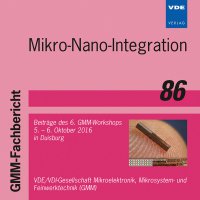Wetting behaviour of LTCC and glasses on nanostructured silicon surfaces during sintering
Konferenz: Mikro-Nano-Integration - 6. GMM-Workshop
05.10.2016 - 06.10.2016 in Duisburg, Deutschland
Tagungsband: Mikro-Nano-Integration
Seiten: 5Sprache: EnglischTyp: PDF
Persönliche VDE-Mitglieder erhalten auf diesen Artikel 10% Rabatt
Autoren:
Gropp, Sebastian; Fischer, Michael; Mueller, Jens; Hoffmann, Martin (Technische Universität Ilmenau, IMN MacroNano, PF 100565, 98694 Ilmenau, Germany)
Inhalt:
Silicon is a great material for active moveable MEMS devices. But it has disadvantages in the field of RF-MEMS due to the low conductivity and the needed First-Level-Integration (e.g. housing). However, there is the possibility to accommodate passive RF components into ceramic carrier, in particular a low-temperature co-fired ceramics (LTCC). Due to the mechanical properties of the LTCC substrates, however, it is not suitable for the construction of movable components. To avoid the disadvantages of both material systems, a composite substrate was developed at the IMN MacroNano(r) at TU Ilmenau, known as SiCer (Silicon on Ceramics). The wetting behaviour of molten glasses, the main component of the LTCC, on nanostructured surfaces is of essential importance for a firm bond between the silicon and the glass.Therefore, the wetting behaviours of glasses and silicon has investigated. It has been found that typical glasses do not wet the silicon surface. This observation can be described by the theory of surface wetting with liquids. Due to the high surface tension of molten glass a high pressure during the sintering step from LTCC and silicon is required. This can lead to plastic deformation of the silicon or induce silicon crystal lattice defects. Therefore, in the second part of this work, the silicon surface has been chemically modified by applying thin layers of metal. This method is also used in case of liquids. In this way, the hydrophobic surface could be converted into a hydrophilic wetting behaviour. Subsequent investigations with sputtered metals on the silicon surface shows a significant pressure reduction during sintering and a more homogeneous and stronger bond interface between silicon and LTCC.


